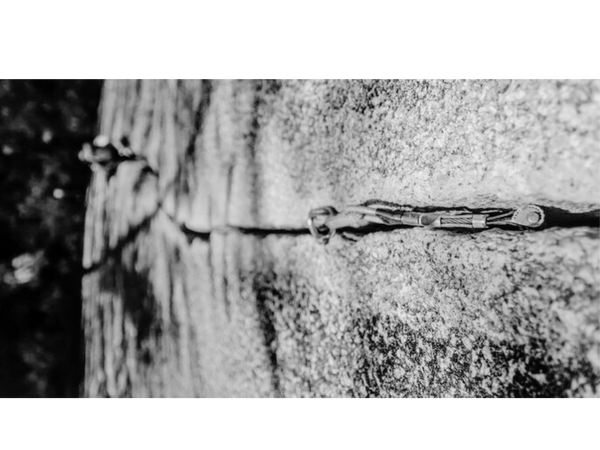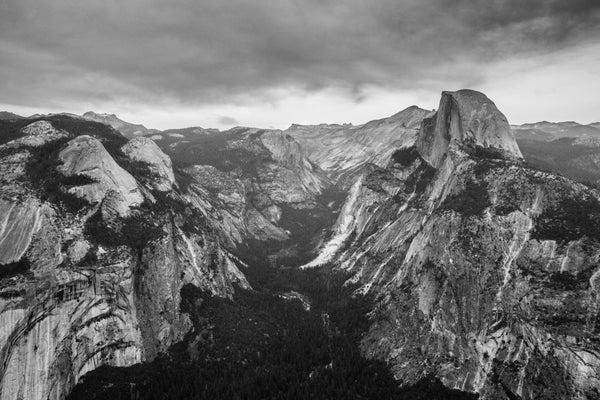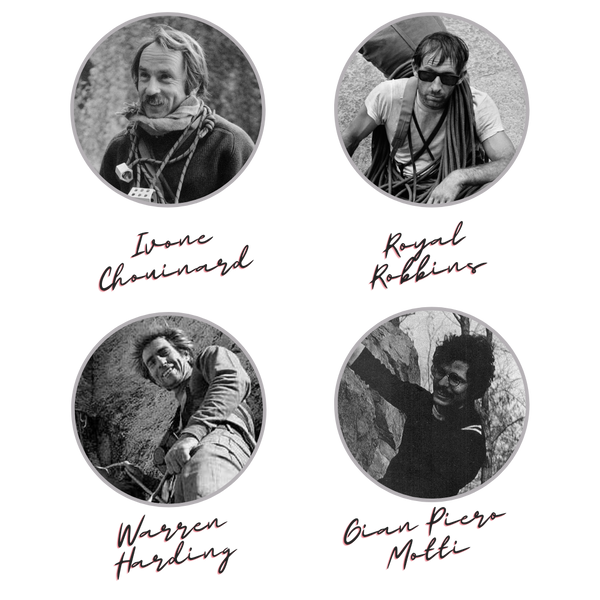The Birth Of Trad Climbing
In the world of rock climbing - and outdoor sports in general - few disciplines captured the essence of adventure and self-reliance like traditional climbing, often referred to as "trad...
In the world of rock climbing - and outdoor sports in general - few disciplines captured the essence of adventure and self-reliance like traditional climbing, often referred to as "trad...

In the world of rock climbing - and outdoor sports in general - few disciplines captured the essence of adventure and self-reliance like traditional climbing, often referred to as "trad climbing". Unlike sport or aid climbing, where climbers rely on pre-placed bolts for protection, trad harks back to the roots of mountaineering, where climbers must place their own protective gear as they ascend. In this article, we'll delve into the captivating world of trad climbing, exploring its history, the gear used, techniques required, and the unique allure that keeps climbers coming back for more.

Trad climbing, where “trad" stands for traditional climbing, has its origins in the early days of mountaineering when climbers sought to conquer formidable peaks by any means necessary. In the late 19th and early 20th centuries, climbers relied on pitons, wooden wedges, and other rudimentary gear to safeguard their ascent. As climbing ethics evolved, the emphasis shifted towards preserving the natural environment, leading to the development of removable protection.
The rise of trad climbing as we know it today can be traced back to the mid-20th century when climbing ethics began to shift towards a more minimalist and environmentally conscious approach. Climbers started to embrace the idea of leaving minimal traces on the natural environment and preserving the rock faces they sought to conquer. This marked a departure from the era of pitons and permanent bolts, which caused irreversible damage to the rock.
During the 1950s and 1960s, a movement known as the Clean Climbing Revolution took hold. Climbers, particularly in places like Yosemite National Park and California’s crags, started to actively remove pitons and began using different kinds of protection such as chocks and hexes. Practically speaking, clean climbing would replace pitons and other bash-in gear with new kinds of protection that were easily removed. This shift laid the groundwork for what we now know as trad climbing. In the end, the ultimate goal of clean climbing was to encourage an ethic where the climber relied only on their judgment and skills, rather than gear, and left zero evidence of their ascent.
In the 1960s and 1970s, pioneers like Royal Robbins, Yvon Chouinard and Warren Harding pushed the boundaries of trad climbing even further in places like Yosemite Valley, California. They introduced innovative protection devices, such as nuts and hexes, that could be easily placed and removed without damaging the rock. This marked a pivotal moment in the history of trad climbing, as it allowed for greater safety without compromising the integrity of the climbing environment. Certainly, the rise of trad climbing in the United States, particularly in California, and in Europe has some notable differences due to historical, cultural, and geographical factors.
Historical Context: Trad climbing in the United States, especially in California, has deep roots in the counterculture movements of the 1960s and 1970s. Climbers in Yosemite Valley were part of the burgeoning outdoor and environmental movements and they embraced the ethos of self-sufficiency and clean climbing with the ultimate goal of preserving the wilderness. Trad climbing in Europe on the other hand, has a longer history, dating back to the late 19th century: alpine climbers in countries like Switzerland and northern Italy were among the early pioneers of traditional alpine and rock climbing deeply influenced by the traditions of mountaineering.
Environment: Yosemite Valley in California became a mecca for trad climbing due to its iconic granite walls, such as El Capitan and Half Dome. These natural features provided an ideal canvas for clean climbing, and the valley attracted climbers from around the world. Europe instead boasted a wide variety of climbing destinations, from the Dolomites in Italy to the Swiss Alps and the limestone cliffs of the French Alps: each region offers distinct challenges and styles of trad climbing, from technical alpine routes to challenging multi-pitch climbs.
Climbing Community: The Yosemite climbing community was closely knit and influential in shaping climbing ethics. Climbers like Royal Robbins and Yvon Chouinard were not only pioneers but also advocates for sustainable practices, and their influence extended beyond California to the broader American climbing community. Europe had a diverse and widespread climbing community with strong traditions in mountaineering. Different countries had their own climbing cultures and histories, resulting in a rich tapestry of climbing styles and approaches.
In summary, while trad climbing shares common principles of self-reliance and minimal environmental impact, its development in the United States (particularly in California) and Europe has been shaped by distinct historical contexts, ethical considerations, climbing destinations, and climbing communities. Both regions have contributed significantly to the global trad climbing movement, each with its own unique character and contributions to the sport. However, these two worlds have not grown independently: it is well known that European and American climbers have influenced each other since the second half of the last century, and trad climbing has represented a meeting point for these communities.
If in Europe mountaineering after WWII was still firmly linked to the traditions of heroic mountaineering and conquest, on the other side of the Atlantic mountaineering had had a completely different development. In the United States there are certainly big mountains of 5000 and 6000 meters, but they are so distant and difficult to access that climbers there have ended up preferring the famous Sierra Nevada and the walls of Yosemite, with peaks of not great height, which however present immense, extraordinary vertical granite walls but lead to grassy fields and not a 4000 mt peaks!

It is clear that this entailed a different concept of mountaineering and climbing. Here it was not a question of overcoming difficulties to reach the summit (which did not exist), but simply of overcoming the wall itself.One of the most incredible things about trad is that it is a movement born simultaneously in the States and in Europe, but with very different aspects and peculiarities. Among the most famous names in the trad scene there are many to take into consideration when talking about innovations, from both sides of the ocean. But there are a few key figures who have made such a great contribution to this style that they have bordered on legend and have fascinated thousands of climbers around the world for decades.

Yvon Chouinard: known as the founder of the outdoor clothing and gear company Patagonia, played a significant role in the evolution of trad climbing. In the 70s he developed the Chouinard Hexentrics, hexagonal-shaped passive protection devices that could be wedged into cracks and removed without causing damage. These hexes were a safer and more environmentally friendly alternative to pitons in the early days of trad climbing.
Royal Robbins: close friend of Chouinard, Royal Robbins was a renowned climber and advocate for clean climbing ethics. He was instrumental in popularizing the use of nuts (small metal wedges) for protection and contributed to the development of modern climbing gear. His bold ascents in Yosemite Valley, including the first ascent of the Salathé Wall on El Capitan, showcased the possibilities of trad climbing.
Warren Harding: While Warren Harding is often associated with controversial first ascents, he was part of the early trad climbing movement in Yosemite. His ascent of El Capitan's Nose Route in 1958, using hundreds of pitons, drew attention to the need for more sustainable climbing practices and contributed to the development of removable protection.
Tom Frost: a climbing partner of Royal Robbins, was an influential figure in the development of climbing gear. He co-founded the company Chouinard Equipment, which later became Black Diamond, and played a key role in designing and manufacturing climbing hardware, including nuts and carabiners.
Gian Piero Motti: far from the spotlight and the allure of the Yosemite’s walls (but deeply inspired by that environment), Motti was one of the most discussed figure of the italian alpine environment. Well known for starting "Il Nuovo Mattino”, a new way of interpreting mountaineering and a philosophy that implies rethinking, and therefore the rebirth, of the traditional mountaineering and climbing style and approach, far from the heroism and epic nature that still permeated the Alpine clubs throughout Europe after the war..
Mike Kosterliz: the only alpinist in the world who is also a nobel prize winner. In 1963 he became one of the leading british climbers in the UK and the Alps, and one of the first to tackle hard routes in Yosemite. The routes opened by Mike in the italian Alps in those years were all experienced with great simplicity, almost quietly, and became over the years a true symbol for future generations. Above all, it gave the Western world a glimpse of how much important was the style (pushing free climbing for an honest and loyal relationship with oneself and nature) with which one climbs walls rather than climbing to the summit at all costs. A message already well understood overseas.
You may have heard of Rotpunkt, that refers to the term coined by Kurt Albert in the mid-1970s at Frankenjura (Albert would paint a red "X" on any fixed metal pitons on a rock climbing route so that he could avoid using them while climbing, thus not using any artificial aid, once he was able to free-climb the entire route he would then paint a red "dot", the "Roter Punkt", at the base of the route). Traditional climbers, as a playful nod to the Rotpunkt movement in sport climbing, coined the term Grünpunkt (greenpointing) to capture the essence of achieving the initial free ascent on a pre-bolted sport climb, relying solely on traditional protection techniques.
Trad climbing gear is designed for versatility and adaptability. Here's a brief overview of the essential equipment needed for trad climbing:
Cams: camming devices come in various sizes and are used to secure cracks in the rock. They expand when placed in a crack, creating a solid anchor point.
Nuts and Hexes: these passive protection pieces are designed to fit into constrictions and fissures in the rock. They are lightweight and versatile.
Nuts tool: this tool helps remove stuck gear, ensuring you don't leave anything behind.
Slings and Carabiners: slings are used to extend the distance between protection points, reducing rope drag. Carabiners are essential for attaching gear to the harness and for building anchor systems.
Helmet: safety is paramount in trad climbing and a helmet protects against falling rocks and debris.

It is well known that in the Czech Republic climbing is mainly done on sandstone and that rock isn't really held together well. Climbing protection like nuts or cams risks damaging the rock, that’s why there are very few bolts or "rings" to clip at the crags down there. It’s a local tradition and is the actual rule: you can only place textile protection, tie knots in ropes and webbing and wedge them in like nuts or hexes

Trad climbing requires a unique set of skills and techniques that go beyond physical strength. Here are some essential trad climbing techniques to master:
Placing Gear: learning to place protection efficiently and securely is fundamental. This involves selecting the right piece of gear for the crack, setting it properly, and ensuring it's placed securely (and possibly fast…)
Building Anchors: trad climbers often need to construct multi-point anchor systems to ensure safety during belays and rappels. This requires knowledge of various anchor-building techniques.
Crack Climbing: Trad climbing frequently involves climbing cracks, which demand specific techniques, such as hand jams, finger locks, and stemming.
Route Finding: Choosing the right line and identifying potential placements for gear is a critical skill in trad climbing.
Rope Management: Managing the rope to minimize drag and reduce the risk of rope entanglement is essential.
As said, trad offers a unique blend of challenges, self-reliance, and connection with nature that keeps climbers returning to the crag time and time again. But why does this style hold a special place in the hearts of climbers all around the world?
We must say that adventure is possibly one of the main reasons, because it makes trad climbing unique: it often takes climbers to remote and pristine locations, providing a sense of exploration and adventure that is not easy to find at your usual crag (unless you stay at Camp 4).
But adventure is not the only thing here. When it comes to problem-solving, placing gear and navigating the rock turn each climb into a mental challenge. Trad climbers are often also strong advocates for preserving the natural environment, as they understand the importance of minimizing impact on the rock. The connection of this style with the pioneers of the sport is also evident here, creating a sense of tradition and history contribute to make this style of climbing cooler than ever.
In other words, trad climbing is a journey to the roots of mountaineering, where the human spirit of adventure and exploration meets the challenges of self-reliance and environmental stewardship. For those willing to embrace its unique demands, it offers a deeply rewarding and enriching experience in the world of outdoor adventure. So, whether you're a seasoned climber looking to expand your horizons or a novice seeking a path less traveled, trad climbing beckons with open arms and endless possibilities.
if you want to know more about trad climbing you can deep dive with this contents:
Your cart is currently empty.
Start Shopping